Dibyendu Mishra, Anmol Panda, Joyojeet Pal
(Suggested citation: Mishra, D., Panda, A., and Pal, J. (2020) Political partisanship and COVID response in India https://joyojeet.people.si.umich.edu/political-partisanship-and-covid-response-in-india/)
We analyzed the timing, frequency, and content of Indian politicians’ tweeting on COVID related issues. We visualized a few key issues that are useful for hypothesis generation.
Leader Effect
First, we see that the key leader has an effect on how much an issue gets recognized by party members. The two figures below, for February 2020 and March 2020 help visualize precisely when members of a party start talking about an issue. While it has been claimed that Rahul Gandhi was the first major leader to talk about the Corona Virus, our archives show that a week before him, Shivraj Chouhan had published an entire thread on it, and outlined his concerns for Madhya Pradesh and Indian students stranded abroad. The Ministry of Health and Family Welfare was early in discussing the Coronavirus, issuing a warning to travellers and notified the public about airport testing on Jan 17, 2020.

However, Chouhan had little or no effect on getting the other BJP leaders to talk about the issue. In Figure 2, we see that during the early phase in Jan 2020, there is relatively less engagement from BJP politicians, despite there already being significant engagement from state agencies including the Press Information Bureau and the Ministry of Health and Family Welfare. It was also a major news item by the end of January both because of the unfolding Wuhan situation but also because by this point India had positive cases in Kerala.

We see in the two figures that while the INC had peaks, its leaders weren’t aggressively tweeting about Coronavirus either. Although both Shashi Tharoor and Rajeev Satav had already tweeted about the issue, it was Rahul Gandhi’s Jan 31, 2020 tweet that he brought attention to the subject within the INC. Indeed, the INC were latecomers to Coronavirus, Pinarayi Vijayan had tweeted about it several times, and smaller parties including CPI(M), TDP, and AITC had all sent out party level messages about Coronavirus before the top leadership in the INC or BJP systematically started tweeting about it. As we see in the left figure 1, the INC itself remained relatively low-key after the initial peak driven by Rahul Gandhi for two weeks until Rahul Gandhi once again tweeted about it, pointing out that the government was not taking it seriously. Yet again, we see that after his tweet, the INC gradually stops tweeting about it.
The graph on the right shows that it was only after Narendra Modi’s first tweet in the first week of February, but the sustained and high-frequency engagement from BJP politicians comes only after Modi’s Janata Curfew address and subsequent messaging.
In short, the data suggest that for a political issue to be taken seriously on social media, the top leader of the party needs to talk about it, and do so in a consistent manner till the rank and file follow.
Leaders and States
The first major state handle (official party handle) to send out a COVID related tweet was BJD. We two clusters of political leaders who have engaged in high-frequency social media engagement about COVID-19 and had an effect in terms of throughput. The first, in the right bubble of Figure 2 are major national leaders who both tweet voluminously and get relatively high retweets – thus are able to get attention. Clearly, Narendra Modi is the most important figure, but others like Amit Shah, Arvind Kejriwal, Piyush Goyal, and Smriti Irani (most prolific in terms of number of days she has tweeted about COVID-19) have engaged regularly, particularly post mid-March, and have had a lot of throughput.
But a second group of politicians, while much less significant in terms of their overall following, have been both regularly engaged with COVID, and in some cases, been more retweeted than some of these key national figures. This second cluster, highlighted to the right of figure 2, includes a number of politicians who are key players in specific states or Chief Ministers, including Pinarayi Vijayan, Ashok Gehlot, Captain Amarinder, Bhupesh Baghel, Biren Singh, and Asad Owaisi.

While some politicians tweet relatively frequently on a daily basis, others tend to tweet in a bursty fashion. While Figure 3 above has the politicians arranged by the number of days they engage with the subject, Figure 4 below is the net number of tweets. We see that as compared to Figure 3, the vast majority of politicians are clustered around the bottom. This means that the volume of tweets is relatively lower. The important standout in this case is the Prime Minister, who both engages frequently in terms of the number of days, and does so with a high number of tweets. The two other important politicians who talk about COVID-19 frequently are Shashi Tharoor and Ashok Gehlot, yet, the relatively small bubbles for both underlines how the Prime Minister dominates both the conversation and the reach around this issue.
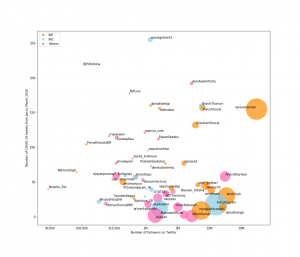
While the key politicians are important in spreading the word, there are also important differences between the various politicians. The politicians at the state level, particularly chief ministers, tend to have more substantive messaging about details of schemes, measures etc, while national-level politicians tend comparatively to make general points or offer inspirational thoughts to citizens. A case in point is that of Pinarayi Vijayan, who despite relatively fewer followers on social media than some of the major national leaders, is very highly retweeted. Figure 5 offers an illustrative example.
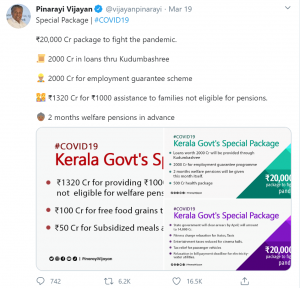
Polarization
We mapped a sampling of hashtags that show statistically significant differences between their use by members of the Congress and the BJP. While there are other parties, that should be mapped for their preferences in their discourse around COVID, we focused on these two key parties due to their often combative relationship on social media. To map polarization, we first conducted a chi square test to find dependence of hashtags on parties. All hashtags that had a p-value < 0.05, were removed from the list. For the rest we log10 scaled the chi square score and assigned a sign based on which party used the hashtag more (- for INC and + for BJP). This signed log chi square score was used as the polarisation metric for the visaualisation.
.
We find that generic hashtags such as CoronaVirus, Covid, Covid19 and extensions of those have very little polarization, and appear on both sides. However, when we map all the COVID related hashtags, several appear to be highly polarized. In Figure 6, we see the spread of key hashtags between the two parties.

First, we see that hashtags related to programs that are seen as Modi’s own initiatives, such as Janatha Curfew, the 21-day lockdown, the 5-minute clapping at 5 PM, and the PM Cares Fund have high purchase among BJP politicians but are not used by INC politicians. Likewise we see that criticisms of the implementation of the lockdown such as issues around migrants or planning of the lockdown are widely used by INC. A few other important patterns emerge. First, we see that the BJP has a fairly standard brand-building style of state-wise hashtag trending that roughly goes (StateName)FightsCorona, and that these are particularly well adopted in the states where the BJP is in power. Similar brand building, deriving from Twitter strategies of earlier campaigns such as SwacchBharat are also seen in the crafting of SayNo2Panic, 5Baje5Minute etc. We also see that anti-Muslim hashtags such as CoronaJihad, or tweets related to Nizamuddin are very far to the right on the figure, suggesting stronger preference among BJP politicians. Anti-Chinese hashtags also tend to trend more among BJP politicians. Finally, while the BJP talks about social distancing, the INC politicians generally eschews this hashtag.
Misinformation and extreme speech
In general, the vast majority of politicians with significant following do not engage in explicit fake news peddling. The first politician with a significant following (100k+) to put out more than one tweet with known fake news was BJP youth wing spokesperson Amrita Bhinder who first tweeted that the Coronavirus came from Chinese bioweapons labs, and subsequently that author Dean Koontz had predicted the Coronavirus in a novel. Both claims have since been debunked.

Besides lower-level party functionaries such as Bhinder, other politicians have indulged in innuendo, including BJP Rajya Sabha MP, Subhash Chandra, who suggested that the virus was driven by some form of human greed. The only top-level politician that we found to have promoted an unverified claim about the pathology of COVID was Subramanian Swamy, who claimed knowing first hand from a scientific source that the Indian strain of the virus was weaker. This message has since been debunked through an analysis of the original sources by the Times of India.
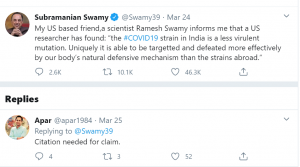
An important trend we find is that of hate speech. While the early hashtags that were hateful or discriminatory tended to be about the Chinese, the more recent hate speech has been about Muslims, specifically following the Nizamuddin incident. Most such tweets tend either to be written as dog whistles from low-ranking party functionaries, such as the tweet in Figure 9 from a Haryana state IT cell head.
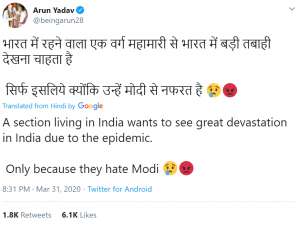
Finally, there are cases of explicit hate speech, these too generally tend to come from low-level leaders or those that do not handle important party posts. One account that puts out a lot of such content is that of Shubhrashtra, a BJP strategist.
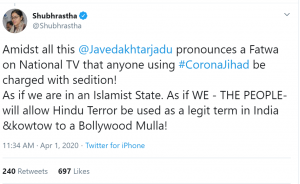
Sampling and Methodology
For collecting tweets related to COVID-19, we first made a preliminary list of related hashtags using stems of obvious terms like ‘ncov’,’virus’,’corona’,’covid’ etc. This process was necessary for capturing tweets that would not explicitly mention COVID-19 related terminology.
We then searched for all tweets in our tweets database from ~18,500 Indian politicians from January to March for the hashtags. More details on the sampling strategy for compiling this list of politicians is available in our previous articles.
We did a partial string matching in both hashtags and tweet texts of the list of words that was created. We used this to find co-occurrence of hashtags that were COVIC-related though did not have explicit mention of the term (for instance #StayAtHomeAndStaySafe, #SocialDistancing), terms that can also be used in other contexts, but due to COVID are contextually specific to this event (for instance #BioJihad #CowUrine) and yet others that are not immediately related to COVID and continue to be used in other contexts, but are relevant to the event only when they co-occur with tweets that also have a COVID-related hashtag (#Migration, #NarendraModi).
Limitations
We only collected English-language hashtags, but since English-language hashtags co-occur with non-English text in tweets, those are represented in the sampling as well. However, this approach does undersample politicians who tweet exclusively in local languages.
Another limitation of our approach is that we only look at hashtag use and the occurrence of precise COVID-related terms that are highly unlikely to be used in other contexts. While this process reduces the inclusion of false positives, we automatically exclude a large number of tweets that are about COVID but do not use explicit terms that can be associated with it. Future work can include Natural Language Inference techniques to include some of those messages.